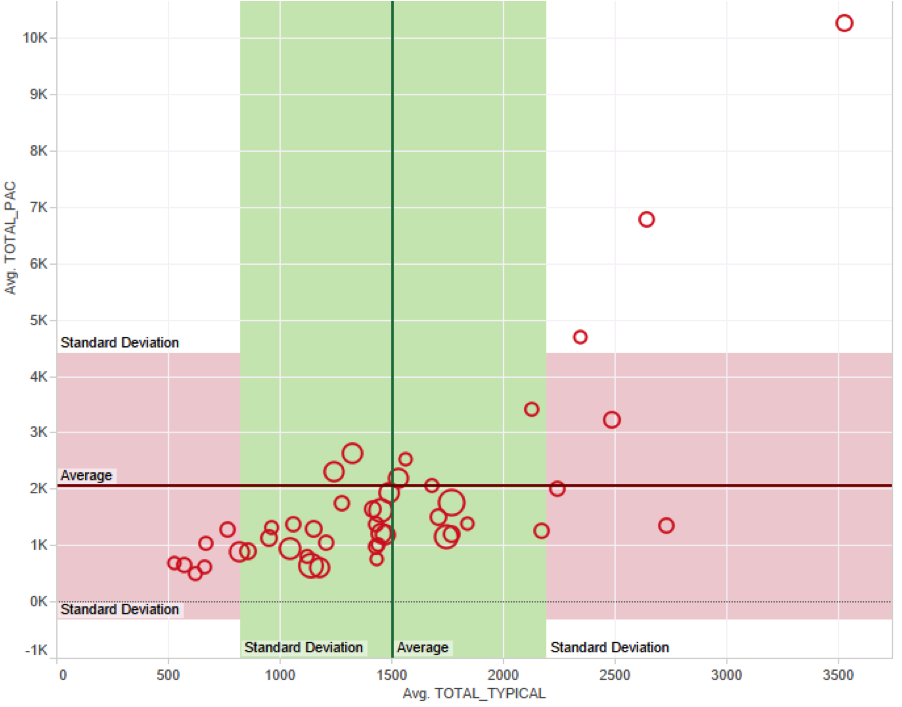Concepts and Use
The PROMETHEUS Analytics® were developed to analyze claims data to create an episode of care that can be used for value-based payment models and performance evaluation in order to improve the quality of care and patient outcomes. Of note, the products in the suite contain all the core components and logic to fully evaluate and support payment reform models by helping you determine:
- What kinds of reform will be most effective and where the reform should be focused
- The potential for savings or improvement of care
- Who are the most efficient and highest quality providers
Key Features
PROMETHEUS Analytics contains key features that no other analytical system currently offers:
1) PROMETHEUS Analytics separates costs of “typical” care from costs associated with potentially avoidable complications, or PACs. PACs, at the core, are events that negatively impact patients and are controllable by providers. The separation of PAC from Typical costs creates performance comparisons of providers as a high PAC rate can be an indicator of low quality whereas a low PAC rate can be associated to high quality care. For example, the following graph shows specific providers, represented by bubbles, and their average costs of PACs and Typical care for a specific episode. Providers in the lower left quadrant are both more efficient and higher quality.

Complications can be a signification source of variation in the total costs of an episode of care. When physicians and hospitals do a deep dive into PACs they can create a plan to decrease overall costs while improving the quality of care.
2) PROMETHEUS Analytics is comprised of an overarching clinical logic in which episodes are associated with one another. This allows inferences about costs of care at many different levels, and can even help determine the appropriateness of procedures in managing patients with certain conditions.
3) While most analytical systems typically have static rules, the PROMETHEUS Analytics allows for flexibility and parameter changes within episodes. This helps to customize episodes to fit customer needs based on what the analysis is being used for (i.e. bundled payments, cost and quality analysis).
The core components of PROMETHEUS Analytics provide a complete and accurate system from which decisions on incentive structures and new payment models can be made. Each of the components, which have been rigorously tested and validated, encompasses valuable elements that apply to the overall goal of reducing costs and improving quality based on existing claims data analysis.
Clinical Logic
Episode construction logic
The episode construction rules for the PROMETHEUS Analytics is comprised of triggers, modifiable parameters, service assignment rules and clinical associations. Each is an important part of how episodes are assembled and analyzed.
- Triggers -- A trigger is the signal or signals that determine when to open an episode and are classified into 4 groups: inpatient facility claim, outpatient facility claim, professional claim and episode.
- Modifiable Parameters -- the modifiable parameters allow flexibility when defining the episode-specific boundaries. These include: episode window, age ranges, coverage gaps and episode minimum and maximum costs.
- Service Assignments -- Service assignments occur after all episodes have been triggered and boundary dates are set. There are four service assignment options: Typical (T), Typical with Complication (TC), Complication (C), and Unassigned (U). The claims containing relevant diagnosis, procedure or pharmacy codes are run through the service assignment rules to classify them as one of the designated options.
- Clinical Association -- Clinical association allows episodes to be connected to one another based on clinical relevance. For any individual patient, conditions and treatments, all of which trigger different ECRs, are often related to one another from a clinical perspective and should be indicated as such. PROMETHEUS Analytics takes into account these associations and link ECRs together based on the definition of typical or complication.
- Typical association - Many procedures are done in stages, such as a bilateral knee replacement where two knee replacements are done sequentially. It is essentially the same episode done at two different times and it is important to link them.
- Complication association - If a patient with coronary artery disease (CAD) suffers a heart attack, which is classified as a complication of CAD, the ECR will trigger an episode for myocardial infarction and, after the episode closes, link it back to the CAD episode already open for that patient.
Provider attribution
Provider attribution assigns a patient or patient-episode to one or more providers based on the specific attribution rule used. Rules can be constructed and modified by the user in order to attribute certain episode types to certain providers. Some examples include:
- Any provider that “touches” the episode/patient can “win” the episode
- All providers with greater than 30% of costs “win” the episode
- Single providers with plurality of costs “wins” the episode
